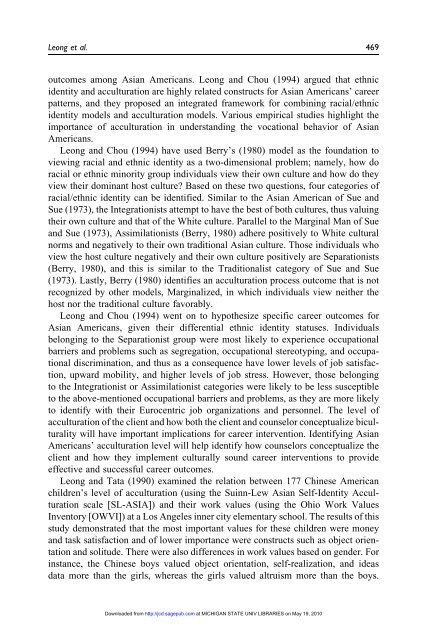A Cultural Formulation Approach to Career ... - ResearchGate
A Cultural Formulation Approach to Career ... - ResearchGate
A Cultural Formulation Approach to Career ... - ResearchGate
You also want an ePaper? Increase the reach of your titles
YUMPU automatically turns print PDFs into web optimized ePapers that Google loves.
Leong et al. 469<br />
outcomes among Asian Americans. Leong and Chou (1994) argued that ethnic<br />
identity and acculturation are highly related constructs for Asian Americans’ career<br />
patterns, and they proposed an integrated framework for combining racial/ethnic<br />
identity models and acculturation models. Various empirical studies highlight the<br />
importance of acculturation in understanding the vocational behavior of Asian<br />
Americans.<br />
Leong and Chou (1994) have used Berry’s (1980) model as the foundation <strong>to</strong><br />
viewing racial and ethnic identity as a two-dimensional problem; namely, how do<br />
racial or ethnic minority group individuals view their own culture and how do they<br />
view their dominant host culture? Based on these two questions, four categories of<br />
racial/ethnic identity can be identified. Similar <strong>to</strong> the Asian American of Sue and<br />
Sue (1973), the Integrationists attempt <strong>to</strong> have the best of both cultures, thus valuing<br />
their own culture and that of the White culture. Parallel <strong>to</strong> the Marginal Man of Sue<br />
and Sue (1973), Assimilationists (Berry, 1980) adhere positively <strong>to</strong> White cultural<br />
norms and negatively <strong>to</strong> their own traditional Asian culture. Those individuals who<br />
view the host culture negatively and their own culture positively are Separationists<br />
(Berry, 1980), and this is similar <strong>to</strong> the Traditionalist category of Sue and Sue<br />
(1973). Lastly, Berry (1980) identifies an acculturation process outcome that is not<br />
recognized by other models, Marginalized, in which individuals view neither the<br />
host nor the traditional culture favorably.<br />
Leong and Chou (1994) went on <strong>to</strong> hypothesize specific career outcomes for<br />
Asian Americans, given their differential ethnic identity statuses. Individuals<br />
belonging <strong>to</strong> the Separationist group were most likely <strong>to</strong> experience occupational<br />
barriers and problems such as segregation, occupational stereotyping, and occupational<br />
discrimination, and thus as a consequence have lower levels of job satisfaction,<br />
upward mobility, and higher levels of job stress. However, those belonging<br />
<strong>to</strong> the Integrationist or Assimilationist categories were likely <strong>to</strong> be less susceptible<br />
<strong>to</strong> the above-mentioned occupational barriers and problems, as they are more likely<br />
<strong>to</strong> identify with their Eurocentric job organizations and personnel. The level of<br />
acculturation of the client and how both the client and counselor conceptualize biculturality<br />
will have important implications for career intervention. Identifying Asian<br />
Americans’ acculturation level will help identify how counselors conceptualize the<br />
client and how they implement culturally sound career interventions <strong>to</strong> provide<br />
effective and successful career outcomes.<br />
Leong and Tata (1990) examined the relation between 177 Chinese American<br />
children’s level of acculturation (using the Suinn-Lew Asian Self-Identity Acculturation<br />
scale [SL-ASIA]) and their work values (using the Ohio Work Values<br />
Inven<strong>to</strong>ry [OWVI]) at a Los Angeles inner city elementary school. The results of this<br />
study demonstrated that the most important values for these children were money<br />
and task satisfaction and of lower importance were constructs such as object orientation<br />
and solitude. There were also differences in work values based on gender. For<br />
instance, the Chinese boys valued object orientation, self-realization, and ideas<br />
data more than the girls, whereas the girls valued altruism more than the boys.<br />
Downloaded from http://jcd.sagepub.com at MICHIGAN STATE UNIV LIBRARIES on May 19, 2010<br />
469
















